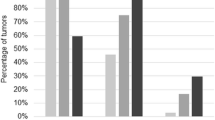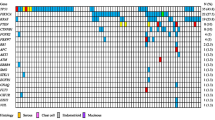Abstract
Objective
The recently cloned gene p16 (MST1) has been identified as a putative tumor suppressor gene that binds to CDK4 and CDK6 (cyclin-dependent kinases), preventing their interaction with cyclin D1 and thereby preventing cell cycle progression at the G1 stage. In addition, the p16 gene has been shown to have a high frequency of mutation in some tumor cell lines; however, it has also been shown that a much lower frequency of mutation occurs in primary tumors. This study investigated the mRNA expression level and mutation status of the p16 gene in ovarian tumors.
Methods
We performed quantitative polymerase chain reaction and direct cDNA sequencing analysis. To confirm the p16 protein level in ovarian tumors, Western blotting and immunohistochemical staining were performed. Expression levels of mRNA for the p16 gene relative to the β-tubulin gene were examined in 32 ovarian tumors (24 carcinomas, six low malignant potential tumors, and two benign tumors) and six normal ovaries.
Results
The mRNA expression level of p16 was significantly elevated in 28 ovarian tumors (22 carcinomas, five low malignant potential tumors, and one benign tumor) compared with that of normal ovaries. Western blotting analysis and immunohistochemical staining confirmed elevated p16 protein levels in ovarian tumor samples. Among 32 ovarian tumors, cDNA sequencing of the p16 gene showed no p16 mutation resulting in a coding error, although one silent mutation and three polymorphisms were found.
Conclusions
Although p16 is seldom mutated in ovarian tumors, the overexpression of p16 in most ovarian tumor cases indicates a dysfunction in the regulatory complex for G1 arrest. Therefore, overexpression of p16 may be an important early event in the neoplastic transformation of the ovarian epithelium.
Similar content being viewed by others
References
Hartwell LH, Kastan MB. Cell cycle control and cancer. Science 1994;266:1821–8.
Hunter T. Braking the cycle. Cell 1993;75:839–41.
Peter M, Herskowitz I. Joining the complex: Cyclin-dependent kinase inhibitory’ proteins and the cell cycle. Cell 1994;79:181–4.
Li Y, Nichols MA, Shay JW, Xiong Y. Transcriptional repression of the D-type cyclin-dependent kinase inhibitor p16 by the retinoblastoma susceptibility gene product pRb. Cancer Res 1994;54:6078–82.
Matsushima H, Ewen ME, Strom DK, et al. Identification and properties of an atypical catalytic subunit (p34psk-33/cdk4) for mammalian D type Gl cyclins. Cell 1992;71:323–34.
Weinberg RA. The retinoblastoma protein and cell cycle control. Cell 1995;81:323–30.
Serrano M, Hannon GJ, Beach D. A new regulatory motif in cell-cycle control causing specific inhibition of cyclin D/CDK4. Nature 1993;366:704–7.
Kamb A, Grins NA, Weaver-Feldhaus J. et al. A cell cycle regulator potentially involved in genesis of many tumor types. Science 1994;264:436–40.
Nobon T, Miura K, We DJ, Lois A, Takabayashi K, Carson D. Deletion of the cyclin-dependent kinase-4 inhibitor gene in multiple human cancers. Nature 1994;368:753–6.
Cairns P, Mao L, Merlo A, et al. Rates of p16 (MTS1) mutations in primary tumors with 9p loss. Science 1994;265:415–6.
Spruck CH III, Gonzalez-Zulueta M, Shibata A, et al. p16 gene in uncultured tumors. Nature 1994;370:183–4.
Okamoto A, Demetrick DJ, Spillare EA, et al. pl6LN,K4 mutations and altered expression in human tumors and cell lines. In: The molecular genetics of cancer. Cold Spring Harbor, New York: Cold Spring Harbor Laboratory Press, 1994:49–57.
Hall JL, Dudley L, Dobner PR, Lewis SA, Cowan NJ. Identification of two human p-tubulin isotypes. Mol Cell Biol 1983;3: 854–62.
Noonan KE, Beck C, Holzmayer TA, et al. Quantitative analysis of MDR1 (multidrug resistance) gene expression in human tumors by polymerase chain reaction. Proc Natl Acad Sci USA 1990;87:7160–4.
Herman JG, Jen J, Merlo A, Baylin SB. Hypermethylation-associated inactivacion indicates a tumor suppressor role for p15INK4B. Cancer Res 1996;56:722–7.
Herman JG, Merlo A, Mao L, et al. lnactivation of the CDKN2/ p16/MTSl gene is frequently associated with aberrant DNA methylation in all common human cancers. Cancer Res 1995;55:4525–30.
Author information
Authors and Affiliations
Additional information
The authors acknowledge the participation of the following divisions of the Cooperative Human Tissue Network (CHTN) in providing tumor tissues: Western Division, Case Western Reserve University (Cleveland, OH); Midwestern Division, Ohio State University (Columbus, OH); Eastern Division. NDRI (Philadelphia, PA); Pediatric Division, Children’s Hospital (Columbus, OH); and Southern Division, University of Alabama at Birmingham (Birmingham, AL).
Rights and permissions
About this article
Cite this article
Shigemasa, K., Hu, C., West, C.M. et al. p16 Overexpression: A Potential Early Indicator of Transformation in Ovarian Carcinoma. Reprod. Sci. 4, 95–102 (1997). https://doi.org/10.1016/S1071-5576(97)81110-0
Published:
Issue Date:
DOI: https://doi.org/10.1016/S1071-5576(97)81110-0




